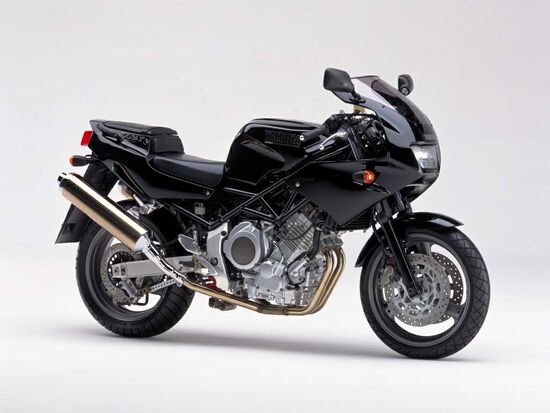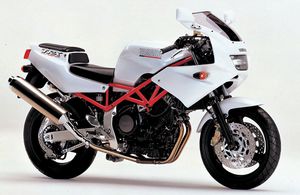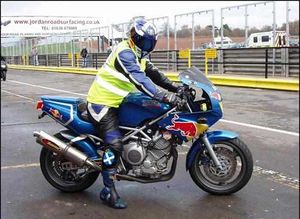Difference between revisions of "Yamaha TRX850"
m |
|||
| (11 intermediate revisions by 2 users not shown) | |||
| Line 1: | Line 1: | ||
| − | {{DISPLAYTITLE: | + | {{DISPLAYTITLE: Yamaha TRX 850}} |
| − | + | __notoc__ | |
| − | + | [[file: Trx-850 1996 1.jpg | 550px | center | Yamaha TRX 850 (Japanese version)]] | |
| − | + | The Yamaha TRX 850 was first introduced in 1995 as a Japanese competitor to the Ducati 900 SS, but with an in-line arrangement (Ducati has a V / L engine layout). | |
| − | + | {{Ads_top}} | |
| − | + | The motor did not become an independent development, but migrated from the second generation [[Yamaha_TDM850 | Yamaha TDM 850]] (270 ° crankshaft), using different camshafts and carburetors (from the first generation [[Yamaha_TDM850 | Yamaha TDM 850]]). This allowed the engine to give the engine a sporty note, forcing it to gain very good revs and not fade at the top, giving out 83 hp. power and 84 Nm of torque. The motor is medium-speed, with maximum performance at 6000-7500 rpm. | |
| − | [[ | ||
| − | |||
| − | |||
| − | + | Initially, in 1995, the TRX850 was only available in the domestic Japanese market, but since 1996, the model has been sold in European countries, where it has gained good popularity. The main visual difference between all European versions and Japanese ones is the front gold Brembo calipers. | |
| − | + | Key features of the Yamaha TRX 850 include the original birdcage frame, sport adjustable suspension, clipon, dry sump lubrication, and efficient 4-piston front brakes. | |
| − | + | Despite its low cost (compared to Ducati), excellent dynamic characteristics, rather good looks and a certain interest from both Japanese and European audiences, the Yamaha TRX 850 never became legendary. In the last years of release, the model still began to gain popularity, but the decision to discontinue production of the Yamaha TRX 850 had already been made - Yamaha did not want to invest in the creation and production of a successor to this model, considering this direction not very promising. As a result, in 1999, the Yamaha TRX 850 was finally discontinued. By the way, the base model [[Yamaha_TDM850 | TDM850]], used as the basis for the TRX850, received much more market acceptance, and as a result, in 2002 it was updated to a completely new one - [[Yamaha_TDM900 | Yamaha TDM900]]. | |
| − | + | However, Yamaha's efforts to create a powerful 2-cylinder sport bike in the image and likeness of Ducati models did not go unnoticed by other Japanese manufacturers. So, in 1997, Honda and Suzuki put on the market their one-liter sports models - [[Honda_VTR1000F | Honda VTR 1000]] and [[Suzuki_TL1000 | Suzuki TL 1000]]. | |
| − | + | == Photos == | |
| − | == | + | {| align = "center" border = "0" |
| − | + | | [[Image: Trx850 199503.jpg | 300px | thumb | right | Yamaha TRX 850]] | |
| − | + | | [[Image: TRX 850 96 5.jpg | 300px | thumb | right | Yamaha TRX 850]] | |
| − | + | | [[Image: 53160trx850trackday.jpg | 300px | thumb | right | Yamaha TRX 850]] | |
| − | |||
| − | |||
| − | |||
| − | |||
| − | |||
| − | |||
| − | |||
| − | |||
| − | |||
| − | |||
| − | |||
| − | |||
| − | |||
| − | |||
| − | |||
| − | |||
| − | |||
| − | |||
| − | |||
| − | |||
| − | |||
| − | |||
| − | |||
| − | |||
| − | |||
| − | |||
| − | |||
| − | |||
| − | |||
| − | |||
| − | |||
| − | |||
| − | |||
| − | |||
| − | |||
| − | |||
| − | |||
| − | |||
| − | |||
| − | |||
| − | |||
| − | |||
| − | |||
| − | |||
| − | |||
| − | |||
| − | |||
| − | {| align="center" border="0" | ||
| − | |[[Image:Trx850 199503.jpg|300px|thumb|right|Yamaha TRX 850]] | ||
| − | |[[Image:TRX 850 96 5.jpg|300px|thumb|right|Yamaha TRX 850]] | ||
| − | |[[Image:53160trx850trackday.jpg|300px|thumb|right|Yamaha TRX 850]] | ||
|- | |- | ||
|} | |} | ||
| − | == | + | {{Ads_feed}} |
| − | + | {{Ads_post}} | |
| − | {| class="wikitable" | + | |
| − | ! scope="row"| | + | == Specifications == |
| − | |Yamaha TRX850 | + | Specifications Yamaha TRX 850: |
| + | {| class = "wikitable" | ||
| + | ! scope = "row" | Model | ||
| + | | Yamaha TRX850 | ||
|- | |- | ||
| − | ! scope="row"| | + | ! scope = "row" | Motorcycle type |
| − | | | + | | sport |
|- | |- | ||
| − | ! scope="row"| | + | ! scope = "row" | Release year |
| − | |1995-1999 | + | | 1995-1999 |
|- | |- | ||
| − | ! scope="row"| | + | ! scope = "row" | Frame |
| − | | | + | | steel, "birdcage" |
|- | |- | ||
| − | ! scope="row"| | + | ! scope = "row" | Engine type |
| − | |2- | + | | 2-cylinder, 4-stroke, in-line |
|- | |- | ||
| − | ! scope="row"| | + | ! scope = "row" | Working volume |
| − | |849 | + | | 849 cc cm. |
|- | |- | ||
| − | ! scope="row"| | + | ! scope = "row" | Bore / stroke |
| − | |89 | + | | 89.5 x 67.5 mm |
|- | |- | ||
| − | ! scope="row"| | + | ! scope = "row" | Compression ratio |
| − | |10.5:1 | + | | 10.5: 1 |
|- | |- | ||
| − | ! scope="row"| | + | ! scope = "row" | Cooling |
| − | | | + | | liquid |
|- | |- | ||
| − | ! scope="row"| | + | ! scope = "row" | Number of valves per cylinder |
| − | |DOHC, 5 | + | | DOHC, 5 valves per cylinder |
|- | |- | ||
| − | ! scope="row"| | + | ! scope = "row" | Fuel supply system |
| − | | | + | | carburetor, 2x Mikuni BDST38 |
|- | |- | ||
| − | ! scope="row"| | + | ! scope = "row" | Ignition type |
| − | | | + | | digital TCI |
|- | |- | ||
| − | ! scope="row"| | + | ! scope = "row" | Maximum power |
| − | |83 | + | | 83.0 h.p. (61.0 kW) at 7500 rpm |
|- | |- | ||
| − | ! scope="row"| | + | ! scope = "row" | Maximum torque |
| − | |84 | + | | 84.3 Nm (8.6 kg-m) at 6000 rpm |
|- | |- | ||
| − | ! scope="row"| | + | ! scope = "row" | Gearbox |
| − | |5- | + | | 5-speed |
|- | |- | ||
| − | ! scope="row"| | + | ! scope = "row" | Drive type |
| − | | | + | | chain |
|- | |- | ||
| − | ! scope="row"| | + | ! scope = "row" | Front tire size |
| − | |120/60 ZR-17 | + | | 120/60 ZR-17 |
|- | |- | ||
| − | ! scope="row"| | + | ! scope = "row" | Rear tire size |
| − | |160/60 ZR-17 | + | | 160/60 ZR-17 |
|- | |- | ||
| − | ! scope="row"| | + | ! scope = "row" | Front brakes |
| − | |2 | + | | 2 discs, 298mm, 4-piston calipers |
|- | |- | ||
| − | ! scope="row"| | + | ! scope = "row" | Rear brakes |
| − | |1 | + | | 1 disc, 245 mm, 2-piston caliper |
|- | |- | ||
| − | ! scope="row"| | + | ! scope = "row" | Front suspension |
| − | | | + | | 41mm telescopic fork (adjustable preload and rebound damping), 120mm travel |
|- | |- | ||
| − | ! scope="row"| | + | ! scope = "row" | Rear suspension |
| − | | | + | | linkage with monoshock (adjustable preload and rebound damping), stroke - 130 mm |
|- | |- | ||
| − | ! scope="row"| | + | ! scope = "row" | Motorcycle length |
| − | |2070 | + | | 2070 mm |
|- | |- | ||
| − | ! scope="row"| | + | ! scope = "row" | Motorcycle width |
| − | |700 | + | | 700 mm |
|- | |- | ||
| − | ! scope="row"| | + | ! scope = "row" | Motorcycle height |
| − | |1155 | + | | 1155 mm |
|- | |- | ||
| − | ! scope="row"| | + | ! scope = "row" | Wheelbase |
| − | |1435 | + | | 1435 mm |
|- | |- | ||
| − | ! scope="row"| | + | ! scope = "row" | Saddle height |
| − | |795 | + | | 795 mm |
|- | |- | ||
| − | ! scope="row"| | + | ! scope = "row" | Acceleration to 100 km / h |
| − | |3 | + | | 3.7 sec |
|- | |- | ||
| − | ! scope="row"| | + | ! scope = "row" | Maximum speed |
| − | |217 | + | | 217 km / h |
|- | |- | ||
| − | ! scope="row"| | + | ! scope = "row" | Fuel tank capacity |
| − | |18 | + | | 18.0 l (including reserve - 3.5 l) |
|- | |- | ||
| − | ! scope="row"| | + | ! scope = "row" | Motorcycle weight (curb) |
| − | |209 | + | | 209 kg |
|- | |- | ||
|} | |} | ||
| − | == | + | == Documentation == |
| − | + | [[Category:Motorcycles]] | |
| − | + | * [[Yamaha_TRX850:_manuals|Yamaha TRX850]] | |
| − | |||
| − | |||
| − | |||
| − | |||
| − | |||
| − | |||
| − | |||
| − | |||
| − | |||
| − | |||
| − | |||
| − | |||
| − | |||
| − | |||
| − | |||
| − | |||
| − | |||
| − | |||
| − | |||
| − | |||
| − | |||
| − | |||
| − | |||
| − | |||
| − | |||
| − | |||
| − | |||
| − | |||
| − | |||
| − | |||
| − | |||
| − | |||
| − | |||
| − | |||
| − | |||
| − | |||
| − | |||
| − | |||
| − | |||
| − | |||
| − | |||
| − | |||
| − | |||
| − | |||
| − | |||
| − | |||
| − | |||
| − | |||
| − | |||
| − | |||
| − | * [[Yamaha_TRX850: | ||
| − | |||
| − | == | + | == == |
| − | + | {{Ads_recomended}} | |
Latest revision as of 20:07, 15 August 2021
The Yamaha TRX 850 was first introduced in 1995 as a Japanese competitor to the Ducati 900 SS, but with an in-line arrangement (Ducati has a V / L engine layout).
The motor did not become an independent development, but migrated from the second generation Yamaha TDM 850 (270 ° crankshaft), using different camshafts and carburetors (from the first generation Yamaha TDM 850). This allowed the engine to give the engine a sporty note, forcing it to gain very good revs and not fade at the top, giving out 83 hp. power and 84 Nm of torque. The motor is medium-speed, with maximum performance at 6000-7500 rpm.
Initially, in 1995, the TRX850 was only available in the domestic Japanese market, but since 1996, the model has been sold in European countries, where it has gained good popularity. The main visual difference between all European versions and Japanese ones is the front gold Brembo calipers.
Key features of the Yamaha TRX 850 include the original birdcage frame, sport adjustable suspension, clipon, dry sump lubrication, and efficient 4-piston front brakes.
Despite its low cost (compared to Ducati), excellent dynamic characteristics, rather good looks and a certain interest from both Japanese and European audiences, the Yamaha TRX 850 never became legendary. In the last years of release, the model still began to gain popularity, but the decision to discontinue production of the Yamaha TRX 850 had already been made - Yamaha did not want to invest in the creation and production of a successor to this model, considering this direction not very promising. As a result, in 1999, the Yamaha TRX 850 was finally discontinued. By the way, the base model TDM850, used as the basis for the TRX850, received much more market acceptance, and as a result, in 2002 it was updated to a completely new one - Yamaha TDM900.
However, Yamaha's efforts to create a powerful 2-cylinder sport bike in the image and likeness of Ducati models did not go unnoticed by other Japanese manufacturers. So, in 1997, Honda and Suzuki put on the market their one-liter sports models - Honda VTR 1000 and Suzuki TL 1000.
Photos
Specifications
Specifications Yamaha TRX 850:
| Model | Yamaha TRX850 |
|---|---|
| Motorcycle type | sport |
| Release year | 1995-1999 |
| Frame | steel, "birdcage" |
| Engine type | 2-cylinder, 4-stroke, in-line |
| Working volume | 849 cc cm. |
| Bore / stroke | 89.5 x 67.5 mm |
| Compression ratio | 10.5: 1 |
| Cooling | liquid |
| Number of valves per cylinder | DOHC, 5 valves per cylinder |
| Fuel supply system | carburetor, 2x Mikuni BDST38 |
| Ignition type | digital TCI |
| Maximum power | 83.0 h.p. (61.0 kW) at 7500 rpm |
| Maximum torque | 84.3 Nm (8.6 kg-m) at 6000 rpm |
| Gearbox | 5-speed |
| Drive type | chain |
| Front tire size | 120/60 ZR-17 |
| Rear tire size | 160/60 ZR-17 |
| Front brakes | 2 discs, 298mm, 4-piston calipers |
| Rear brakes | 1 disc, 245 mm, 2-piston caliper |
| Front suspension | 41mm telescopic fork (adjustable preload and rebound damping), 120mm travel |
| Rear suspension | linkage with monoshock (adjustable preload and rebound damping), stroke - 130 mm |
| Motorcycle length | 2070 mm |
| Motorcycle width | 700 mm |
| Motorcycle height | 1155 mm |
| Wheelbase | 1435 mm |
| Saddle height | 795 mm |
| Acceleration to 100 km / h | 3.7 sec |
| Maximum speed | 217 km / h |
| Fuel tank capacity | 18.0 l (including reserve - 3.5 l) |
| Motorcycle weight (curb) | 209 kg |
Documentation



